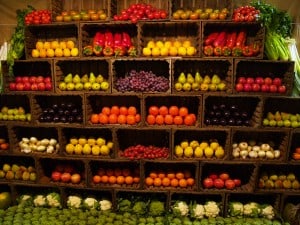Cold season is here, I found this great article from Dr. Fuhrman, a great reminder that food is our best medicine:
Immune-boosting foods for cold & flu season from Dr. Joel Fuhrman
 From Dr. Joel Fuhrman, author of Super Immunity.
From Dr. Joel Fuhrman, author of Super Immunity.
The weather is beginning to cool down, and soon cold and flu season
will be upon us. Cold and flu are a larger burden than we may think.
Between treatments, illness-compromised productivity, and lost workdays,
it is estimated that the common cold alone costs the U.S. $40 billion
each year.
1
We all know the basics for reducing exposure – wash your hands, avoid
touching your face, and avoid being exposed to people who are already
ill. However, exposure to these viruses is not the only factor here –
excellent nutrition can reduce our vulnerability to infection and reduce
the length and severity of illness if we do become infected.
Many micronutrients are required to support proper function of the
immune system, and phytochemicals from colorful produce have additional
anti-microbial and immune-boosting effects. A well-nourished body
houses a high-functioning immune system.
Mushrooms
Mushrooms have a unique ability to activate the body’s natural immune
defenses. Reishi and shiitake mushrooms enhance activity of natural
killer (NK) cells, which attack cancerous and virus-infected cells.
2, 3 Shiitake mushrooms protect against influenza infection in animal studies.
4-6
Fortunately though, it is not only exotic mushrooms that benefit the
immune system. Eating white button mushrooms daily was found to enhance
immune defenses in mucosal linings such as those in the mouth and
respiratory tract.
7
Dendritic cells are another type of immune cell that protects the
respiratory tract, and their activity is also enhanced by white button
mushroom phytochemicals.
8
Cruciferous vegetables
The cruciferous family of vegetables includes kale, collards, mustard
greens, arugula, watercress, broccoli, broccoli rabe, cabbage,
cauliflower, kohlrabi, and more. The bitter, spicy, or pungent flavors
of these vegetables are provided by glucosinolates, which are converted
into potent anti-cancer compounds called isothiocyanates (ITCs) upon
chopping or chewing. In addition to their anti-cancer effects, ITCs also
support the immune system and have antimicrobial properties.
Cruciferous vegetable phytochemicals may enhance interferon activity,
which is an important component of the body’s antiviral response.
9, 10
Berries
Berries are powerful anti-cancer foods that also offer protection
against viruses. Antioxidants called flavonoids, which are abundant in
berries, have antiviral activity.
11 In fact, if you do get the flu, taking anthocyanin-rich elderberry juice may even shorten the duration of your symptoms.
12-14
Berries and grapes are also rich in resveratrol, another antioxidant
phytochemical with strong antiviral effects – resveratrol has been shown
to block the replication of influenza and other respiratory viruses.
15-17 Plus, strawberries are high in vitamin C, which protects immune cells from oxidative damage.
18
The benefits of berries go far beyond cold & flu protection.
Flavonoid antioxidants like those in berries are not just antioxidants –
flavonoids also act on signaling within the cell leading to many
beneficial effects: flavonoids activate the body’s natural
detoxification enzymes, block the growth of cancer cells, decrease
inflammation, and support proper blood pressure regulation.
19
Berries (and pomegranates) are also extremely rich in another
antioxidant called ellagic acid, a compound known to block cancer cell
and tumor growth.
20-22
Onions & garlic
There is no convincing evidence for using garlic supplements for symptoms of the common cold.
23
However, eating garlic and onions daily has clear benefits when it
comes to cancer prevention, and may also help to build immune defenses,
including macrophage, T cell, and NK cell activity.
24, 25 Plus, several garlic phytochemicals have virus-killing activity against common respiratory viruses.
26
By eating nutrient-dense plant foods (vegetables, fruits, beans,
seeds and nuts) every day, you will provide your body with a spectrum of
immunity-boosting phytochemicals, and you’ll get an additional perk too
– these same foods protect against heart disease, cancer, diabetes, and
other devastating chronic illnesses.
Read more:
http://elixirliving.com/immune-boosting-foods-for-cold-flu-season/














